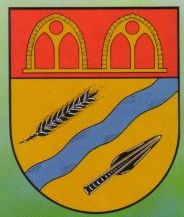Schinna: Difference between revisions
Knorrepoes (talk | contribs) m (Text replacement - " / Arms" to "/Arms") |
Knorrepoes (talk | contribs) m (Text replacement - "Literature :" to "'''Literature''':") |
||
| Line 28: | Line 28: | ||
{{media}} | {{media}} | ||
[[Civic Heraldry Literature - Germany|Literature]] : Ziegler, 1997 | [[Civic Heraldry Literature - Germany|'''Literature''']]: Ziegler, 1997 | ||
[[Category:German Municipalities S]] | [[Category:German Municipalities S]] | ||
Revision as of 06:58, 10 September 2022
This page is part of the German heraldry portal Deutsche Wappensammlung |
Heraldry of the World |
|
German heraldry:
|
Selected collector's items from Germany:
|
STOLZENAU
State : Niedersachsen
District (Kreis) : Nienburg
Incorporated into : 1974 Stolzenau
| German | Unter rotem Schildhaupt, darin zwei goldene Jochfelder eines Kreuzganges mit roten Lichtöffuungen, in Gold ein blauer schräglinker Welle nbalken, begleitet oben von einer schwarzen Ähre und unten von einer schwarzen Lanzenspitze. |
| English | No blazon/translation known. Please click here to send your (heraldic !) blazon or translation |
Origin/meaning
The arms were designed for the village in 1997.
The wavy bend refers to the Weser river. The wheatear to the agricultural character of the village since the Bronze Age. The spear-tip is a Bronze Age find in the village and indicates the longtime inhabitation and cultivation of the area. It also refers to the many Bronze Age artifacts found in the area.
The chief refers to the monasteries that played a major role in the local history. The first monastery was founded in Schinna in 1148 by Count Wullbrand von Hallermund. Another monastery was founded close to the village in Loccum. These two monasteries are symbolised by the two windows in the chief. The design is based on the still visible remains of the monasteries.
Contact and Support
Partners:
Your logo here ?
Contact us
© since 1995, Heraldry of the World, Ralf Hartemink 
Index of the site
Literature: Ziegler, 1997












